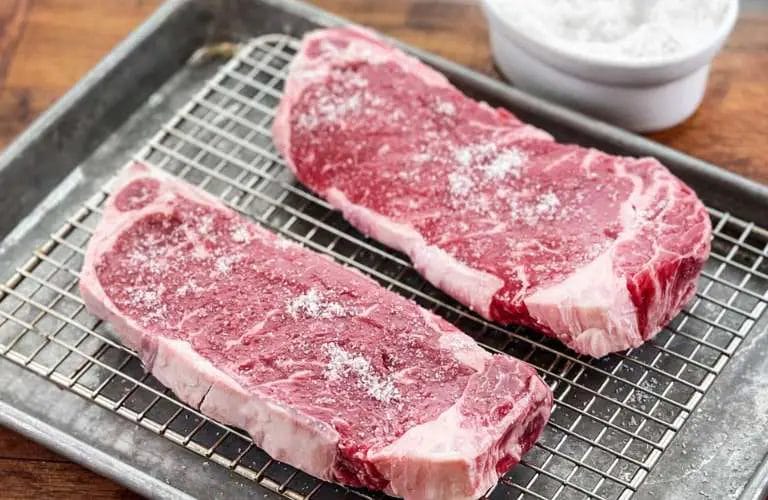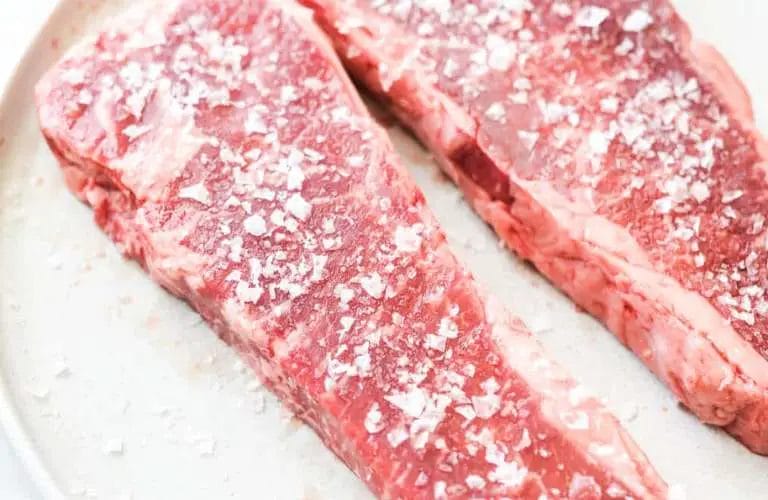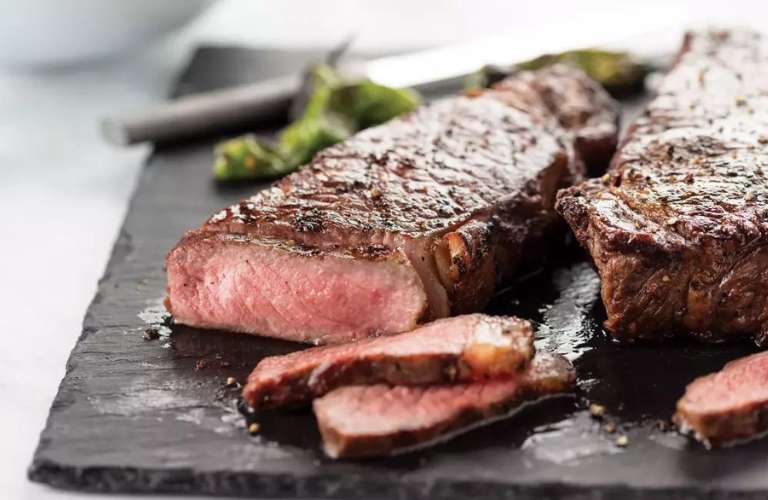Dry brining is a simple yet effective technique to enhance the flavor and juiciness of your steak. Unlike traditional wet brining, this method involves generously seasoning the steak with salt and allowing it to rest in the refrigerator for a designated amount of time.
The salt draws out moisture from the steak while also infusing it with flavor. As a result, you get a perfectly seasoned and tender steak with a rich and delicious taste.
In this article, we will guide you through the process of dry brining a steak to elevate your grilling experience.

Benefits of Dry Brining for Steak
Dry brining is a method of seasoning meat that involves rubbing salt and other seasonings directly onto the surface of the meat and allowing it to sit for an extended period of time before cooking. This technique has gained popularity among steak enthusiasts for several reasons:
1. Enhanced Flavor
Dry brining helps to enhance the natural flavors of the steak. The salt draws out the moisture from the meat, which then mixes with the seasonings and forms a flavorful brine. This brine is then reabsorbed back into the steak, resulting in a steak that is well-seasoned throughout.
2. Improved Moisture Retention
Contrary to what the name suggests, dry brining actually helps the steak retain moisture. By drawing out the moisture initially, the salt creates a concentrated brine that helps to retain the juices during the cooking process. This leads to a juicier and more tender steak.
3. Tenderizes the Meat
The salt in the dry brine helps to break down the muscle fibers in the steak, resulting in a more tender texture. This is especially beneficial for tougher cuts of meat, as it helps to make them more enjoyable and easier to chew.
4. Improved Crust Formation
When a dry-brined steak is cooked, the surface becomes drier, which facilitates the development of a flavorful crust. This crust adds a delightful crunch and texture to the steak, enhancing the overall eating experience.
5. Time-Saving
Dry brining can be a time-saving technique compared to traditional wet brining. With dry brining, there is no need to wait for the meat to soak in a liquid brine. Instead, you simply apply the dry brine directly onto the steak and let it sit in the refrigerator. This allows you to marinate the steak while also going about your other preparations.
6. Versatility
Dry brining is a versatile technique that can be used on various cuts and types of steak. Whether you prefer a ribeye, sirloin, or tenderloin, dry brining can enhance the flavor and texture of any cut. It also works well for different cooking methods, such as grilling, pan-searing, or broiling.
7. Consistent Results
One of the advantages of dry brining is that it consistently produces great results. The salt and seasonings evenly distribute across the steak, ensuring that every bite is well-seasoned. This eliminates the risk of uneven seasoning that can occur with other seasoning methods.
8. Easy Cleanup
Unlike wet brining, dry brining requires minimal cleanup. There are no buckets or containers of brine to deal with, and you simply need to discard the excess dry brine from the surface of the steak before cooking.
9. Cost-Effective
Dry brining requires only a small amount of salt and seasonings, making it a cost-effective method of seasoning steak. You can achieve great flavor and results without needing to purchase large quantities of ingredients.

Step-by-Step Guide to Dry Brining a Steak
Dry brining is a technique used to enhance the flavor and tenderness of meat, and it works wonders on steaks. Unlike traditional wet brining, which involves submerging the meat in a liquid solution, dry brining involves coating the meat with salt and allowing it to rest.
This process draws out moisture from the meat, which is then reabsorbed, resulting in a more flavorful and juicy steak. If you’re ready to take your steak game to the next level, follow this step-by-step guide to dry brining a steak.
Step 1: Choose the Right Steak
Start by selecting a high-quality steak. Look for a well-marbled cut, such as ribeye, strip steak, or T-bone. The marbling, which refers to the fat distributed throughout the meat, adds flavor and juiciness to the steak. Additionally, choose a steak that is at least 1-inch thick to ensure even cooking.
Step 2: Season with Salt
Generously season both sides of the steak with kosher salt. Kosher salt is preferred over table salt because it has larger crystals, which adhere better to the meat.
The amount of salt you use will depend on the size of the steak, but a good rule of thumb is to use about 1 teaspoon of salt per pound of meat. Pat the salt into the steak to ensure it sticks.
Step 3: Let the Steak Rest
Once the steak is seasoned, place it on a wire rack set over a baking sheet. This allows air to circulate around the steak and helps to dry the surface, resulting in a better crust when cooked.
Let the steak rest in the refrigerator for at least 1 hour, but ideally overnight. The longer you let it rest, the more flavorful and tender it will become.
Step 4: Preheat the Grill or Pan
Before cooking the steak, preheat your grill or pan. For grilling, preheat the grill to medium-high heat. If using a pan, preheat it over medium-high heat until hot. Preheating ensures that the steak cooks evenly and develops a nice sear.
Step 5: Cook the Steak
Remove the steak from the refrigerator and let it come to room temperature for 30 minutes.
This allows the meat to cook more evenly. Place the steak on the preheated grill or pan and cook for about 4-6 minutes per side for medium-rare, or until the desired level of doneness is reached. Use a meat thermometer to ensure the steak is cooked to your preference.
Step 6: Rest and Serve
Once the steak is cooked, transfer it to a cutting board and let it rest for 5-10 minutes. This allows the juices to redistribute throughout the meat, resulting in a more tender and flavorful steak. After resting, slice the steak against the grain and serve immediately. Enjoy your perfectly dry brined steak!

Choosing the Right Salt for Dry Brining
Dry brining is a popular technique used to enhance the flavor and juiciness of meats. It involves applying salt to the surface of the meat and allowing it to sit for a certain period of time.
The salt draws out moisture from the meat, which is then reabsorbed along with the salt, resulting in a more flavorful and tender end product. However, not all salts are created equal when it comes to dry brining.
Here are some factors to consider when choosing the right salt for dry brining.
1. Coarseness of the Salt
When dry brining, it is important to use a coarse salt rather than a fine salt. Coarse salt has larger crystals, which makes it ideal for evenly distributing the salt over the surface of the meat.
Fine salt, on the other hand, can easily clump together and create uneven pockets of salt on the meat, leading to inconsistent flavoring.
2. Type of Salt
There are several types of salts available, each with its own unique taste profile. Here are some common types of salts that are suitable for dry brining:
- Kosher Salt: This is a popular choice for dry brining due to its coarse texture and mild flavor. It dissolves easily and evenly, ensuring consistent flavoring throughout the meat.
- Sea Salt: Sea salt is harvested from evaporated seawater and comes in various grain sizes. It can add a subtle briny flavor to the meat, enhancing its natural taste.
- Himalayan Pink Salt: This salt is known for its distinctive pink color and mineral-rich composition. It has a milder flavor compared to kosher salt and can lend a subtle earthiness to the meat.
- Flake Salt: Flake salt, such as Maldon salt, has delicate, pyramid-shaped crystals that provide a pleasant crunch. It can add a finishing touch to the meat, enhancing both its flavor and texture.
3. Quality of the Salt
When it comes to dry brining, quality matters. Opt for high-quality salts that are free of additives and impurities. Look for salts that are minimally processed and retain their natural minerals and trace elements.
These salts not only enhance the flavor of the meat but also contribute to its overall quality.
4. Consider the Meat
The type of meat you are brining can also influence your choice of salt. For delicate meats like fish or poultry, a milder salt with a finer texture may be preferred to avoid overpowering the natural flavors.
For heartier meats like beef or pork, a coarser salt with a stronger flavor can help penetrate the meat and create a more pronounced taste.
Recommended Time for Dry Brining a Steak
Dry brining is a technique used to enhance the flavor and tenderness of meat, particularly steak. It involves coating the meat with salt and allowing it to rest in the refrigerator for a certain period of time before cooking.
This process not only seasons the meat but also helps to draw out moisture, resulting in a more concentrated flavor and a tender texture. When it comes to dry brining a steak, the recommended time can vary depending on the thickness and cut of the meat.
Here are some general guidelines to follow:
1. Thickness of the Steak
The thickness of the steak plays a significant role in determining the recommended brining time. Thicker cuts of steak require more time for the salt to penetrate and work its magic. As a general rule of thumb, you should dry brine a steak for approximately 1 hour per inch of thickness.
For example, if you have a 1.5-inch thick steak, you would want to dry brine it for about 1.5 hours. This allows enough time for the salt to fully penetrate the meat, resulting in a more flavorful and tender steak.
2. Type of Cut
The type of cut also influences the recommended brining time. Different cuts of steak have varying levels of tenderness and flavor, which can affect how long they need to be brined.
Generally, less tender cuts benefit from longer brining times to help break down the muscle fibers and enhance their tenderness.
For example, a tougher cut like a flank steak or skirt steak may benefit from being dry brined for a longer period, such as 2 to 4 hours. On the other hand, a more tender cut like a filet mignon or ribeye may only require 1 to 2 hours of brining.
3. Desired Flavor Intensity
The desired flavor intensity is a personal preference that can also influence the recommended brining time. If you prefer a more subtle flavor, a shorter brining time may be sufficient.
However, if you are looking for a more pronounced and flavorful steak, you may want to extend the brining time.
It’s important to note that while dry brining can greatly enhance the flavor and tenderness of a steak, it’s crucial not to over-brine the meat.
Over-brining can lead to an overly salty taste and a dry texture. Therefore, it’s essential to follow the recommended brining times based on the factors mentioned above.

Tips and Tricks for Perfectly Dry Brined Steak
When it comes to cooking steak, one of the best techniques to enhance its flavor and tenderness is dry brining. Dry brining involves seasoning the steak with salt and allowing it to sit in the refrigerator for a certain period of time.
This process helps to break down the muscle fibers, resulting in a more juicy and flavorful steak. To achieve the perfect dry brined steak, here are some tips and tricks to keep in mind:
1. Choose the Right Steak
The first step to achieving the perfect dry brined steak is to choose the right cut of meat. Look for well-marbled cuts such as ribeye or strip steak.
The fat marbling not only adds flavor but also helps to keep the meat moist during the cooking process. Opt for steaks that are at least 1-inch thick to ensure even cooking.
2. Season Generously
When it comes to dry brining, it’s important to season the steak generously with salt. The salt helps to draw out the moisture from the steak, which is then reabsorbed, resulting in a more flavorful and tender meat.
Use approximately 1 teaspoon of kosher salt per pound of steak, ensuring that all sides are evenly coated.
3. Let it Rest
Once the steak is seasoned, it’s crucial to let it rest in the refrigerator for an extended period of time. This allows the salt to penetrate the meat and work its magic.
Leave the steak uncovered on a wire rack set over a baking sheet to allow air circulation. For best results, let it rest for at least 1 hour, but overnight is even better.
4. Pat Dry Before Cooking
Before cooking the dry brined steak, it’s important to pat it dry with a paper towel. This removes any excess moisture on the surface, allowing for better browning and caramelization during the cooking process.
Moisture on the surface can hinder the development of a flavorful crust on the steak.
5. Bring to Room Temperature
Prior to cooking, allow the dry brined steak to come to room temperature. This ensures more even cooking throughout the steak. Remove it from the refrigerator about 30 minutes before cooking and let it rest on the counter. This step helps to achieve a more evenly cooked steak.
6. Cook to the Right Temperature
Cook the dry brined steak to the desired level of doneness using a meat thermometer. This ensures that you achieve the perfect level of tenderness.
For a medium-rare steak, cook until the internal temperature reaches 135°F (57°C). Remember to let the steak rest for a few minutes before slicing to allow the juices to redistribute.
7. Experiment with Flavors
While salt is the main seasoning for dry brining, you can also experiment with other flavors to enhance the taste of your steak. Consider adding herbs, spices, or even a garlic and herb butter to further elevate the flavor profile.
Get creative and explore different combinations to find your perfect steak seasoning.

FAQs
How do you dry brine a steak?
To dry brine a steak, generously sprinkle kosher salt on all sides of the steak and let it sit in the refrigerator for at least 1 hour or overnight. The salt will draw out moisture from the steak, which will then be reabsorbed, resulting in a seasoned and tenderized steak with enhanced flavor.
Conclusion
In conclusion, dry brining is a simple and effective technique to elevate the flavor and tenderness of your steak. By applying a generous amount of salt and allowing it to rest on the meat for a period of time, you can achieve a perfect balance of seasoning and moisture retention.
The dry brining process helps to break down the proteins, resulting in a more tender and juicy steak. Additionally, the concentrated flavors from the salt enhance the natural taste of the meat, making each bite a tantalizing experience.
So, next time you cook a steak, don’t forget to try the dry brining method for an exceptional dining experience.
Remember, practice makes perfect when it comes to dry brining. Experiment with different types of salt and seasonings to find your preferred flavor profile. Don’t be afraid to let the steak rest for longer periods of time for a more intense flavor.
So, whether you’re grilling, pan-searing, or broiling your steak, give dry brining a try and take your steak to a whole new level of deliciousness. Happy cooking!

